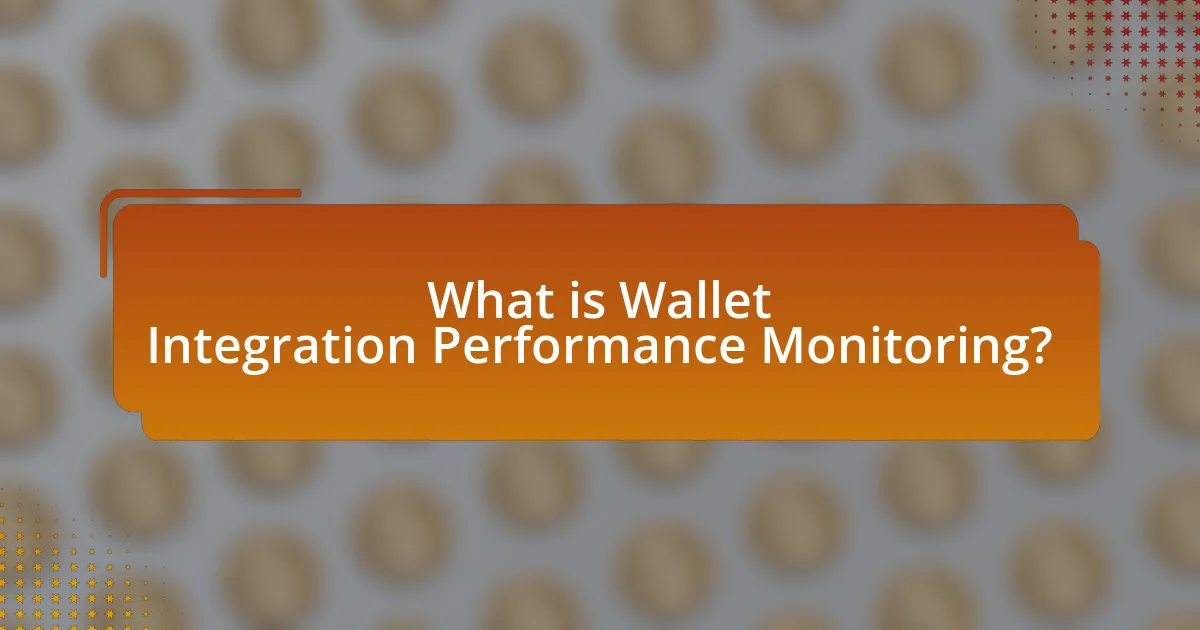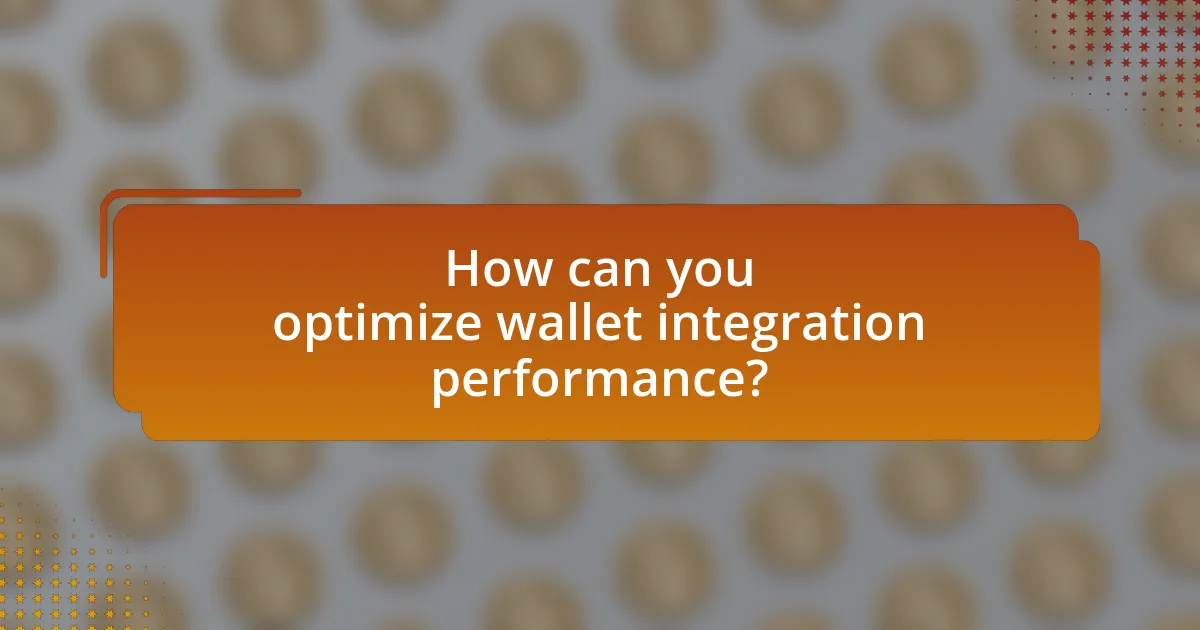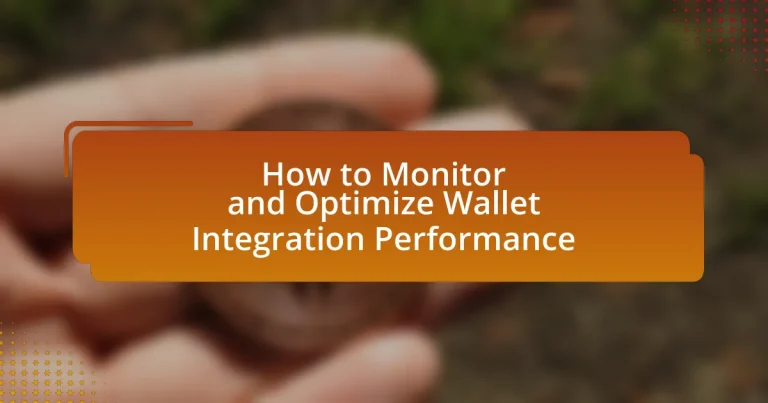Wallet Integration Performance Monitoring is a critical process that involves tracking and analyzing the efficiency of digital wallet integrations within applications. This article outlines the importance of monitoring key performance indicators such as transaction speed, error rates, and user experience metrics to enhance transaction reliability and user satisfaction. It discusses the methodologies for effective monitoring, the key metrics to assess performance, and the tools available for analysis. Additionally, the article highlights best practices for optimization, common challenges, and the implications of scaling wallet integration, providing a comprehensive guide for improving wallet integration performance management.

What is Wallet Integration Performance Monitoring?
Wallet Integration Performance Monitoring is the process of tracking and analyzing the efficiency and effectiveness of digital wallet integrations within applications or platforms. This monitoring involves assessing key performance indicators such as transaction speed, error rates, and user experience metrics to ensure that wallet functionalities operate smoothly and meet user expectations. Effective performance monitoring can lead to improved transaction reliability and user satisfaction, as evidenced by studies showing that optimized wallet integrations can increase user retention rates by up to 30%.
How does wallet integration performance monitoring work?
Wallet integration performance monitoring works by tracking and analyzing the interactions between a digital wallet and the associated payment systems to ensure optimal functionality and user experience. This process involves collecting data on transaction speeds, success rates, error rates, and user engagement metrics. By utilizing analytics tools and performance dashboards, developers can identify bottlenecks, troubleshoot issues, and implement improvements. For instance, monitoring tools can reveal that a specific payment gateway is causing delays, allowing for targeted optimizations. This data-driven approach ensures that wallet integrations operate efficiently, enhancing user satisfaction and increasing transaction reliability.
What are the key metrics for assessing wallet integration performance?
Key metrics for assessing wallet integration performance include transaction success rate, average transaction time, user adoption rate, and customer satisfaction score. The transaction success rate measures the percentage of completed transactions versus attempted transactions, indicating reliability. Average transaction time assesses the speed of processing, which impacts user experience. User adoption rate reflects the percentage of users actively utilizing the wallet integration, demonstrating its acceptance. Customer satisfaction score, often gathered through surveys, provides insights into user experience and areas for improvement. These metrics collectively offer a comprehensive view of wallet integration effectiveness and user engagement.
How do these metrics influence user experience?
Metrics such as transaction speed, error rates, and user engagement directly influence user experience by determining how smoothly and efficiently users can interact with wallet integrations. For instance, faster transaction speeds enhance user satisfaction by reducing wait times, while lower error rates minimize frustration and increase trust in the system. Additionally, high user engagement metrics indicate that users find the wallet integration valuable and easy to use, which can lead to increased adoption and retention. Studies show that a 1-second delay in transaction processing can lead to a 7% reduction in conversions, highlighting the critical role these metrics play in shaping user experience.
Why is monitoring wallet integration performance important?
Monitoring wallet integration performance is important because it ensures the reliability and efficiency of transactions within digital wallets. By tracking performance metrics, businesses can identify issues such as transaction delays or failures, which can directly impact user experience and trust. For instance, a study by the Cambridge Centre for Alternative Finance found that 40% of users abandon transactions due to slow processing times. Therefore, consistent monitoring allows for timely optimizations, enhancing user satisfaction and retention while minimizing potential revenue loss.
What risks are associated with poor wallet integration performance?
Poor wallet integration performance poses several risks, including transaction failures, security vulnerabilities, and user dissatisfaction. Transaction failures can lead to lost sales opportunities, as customers may abandon their purchases if the payment process is unreliable. Security vulnerabilities arise when integration issues expose sensitive data, increasing the risk of fraud and data breaches. User dissatisfaction can result from a frustrating payment experience, leading to decreased customer loyalty and negative brand perception. According to a study by the Baymard Institute, 18% of users abandon their carts due to a complicated checkout process, highlighting the importance of seamless wallet integration for maintaining customer engagement and trust.
How can effective monitoring enhance security and reliability?
Effective monitoring enhances security and reliability by providing real-time visibility into system performance and potential vulnerabilities. This proactive approach allows organizations to detect anomalies, unauthorized access, and system failures promptly. For instance, according to a study by the Ponemon Institute, organizations that implemented continuous monitoring reduced the average time to detect a data breach from 206 days to 66 days, significantly minimizing potential damage. By analyzing logs and alerts, effective monitoring can identify patterns indicative of security threats, enabling timely responses that bolster overall system integrity and trustworthiness.

What tools are available for monitoring wallet integration performance?
Tools available for monitoring wallet integration performance include Google Analytics, Mixpanel, and Hotjar. Google Analytics provides insights into user interactions and transaction flows, allowing developers to track performance metrics effectively. Mixpanel offers advanced analytics for user engagement and retention, enabling teams to analyze wallet usage patterns. Hotjar complements these tools by providing heatmaps and session recordings, which help visualize user behavior during wallet transactions. These tools collectively enhance the ability to monitor and optimize wallet integration performance by delivering actionable data and insights.
How do different monitoring tools compare?
Different monitoring tools vary significantly in their features, usability, and effectiveness for tracking wallet integration performance. For instance, tools like New Relic and Datadog offer comprehensive application performance monitoring with real-time analytics, while Prometheus focuses on time-series data and is highly customizable. Additionally, Grafana excels in data visualization, allowing users to create detailed dashboards, whereas tools like Sentry specialize in error tracking and performance monitoring for applications. The choice of monitoring tool often depends on specific needs, such as the level of detail required, ease of integration, and the type of metrics being monitored.
What features should you look for in a wallet monitoring tool?
A wallet monitoring tool should include real-time transaction tracking, alert notifications for suspicious activities, and comprehensive reporting features. Real-time transaction tracking allows users to monitor their wallet activity as it happens, ensuring immediate awareness of any changes. Alert notifications for suspicious activities help users respond quickly to potential security threats, enhancing the overall safety of their assets. Comprehensive reporting features provide insights into transaction history and wallet performance, enabling users to analyze trends and optimize their wallet usage effectively. These features collectively ensure that users can maintain control and security over their digital assets.
How can integration with existing systems enhance monitoring capabilities?
Integration with existing systems enhances monitoring capabilities by enabling seamless data flow and real-time analytics across platforms. This integration allows for the aggregation of diverse data sources, which improves visibility into system performance and user interactions. For instance, when a wallet integration is connected to transaction processing systems, it can provide immediate insights into transaction success rates and user behavior patterns. Research indicates that organizations leveraging integrated monitoring solutions can reduce incident response times by up to 50%, demonstrating the effectiveness of such integrations in enhancing operational efficiency and decision-making.
What are the best practices for using monitoring tools?
The best practices for using monitoring tools include defining clear objectives, selecting appropriate metrics, and ensuring real-time data analysis. Clear objectives guide the monitoring process, allowing teams to focus on relevant performance indicators. Selecting appropriate metrics, such as transaction success rates and response times, provides actionable insights into wallet integration performance. Real-time data analysis enables immediate detection of issues, facilitating prompt resolution. According to a study by Gartner, organizations that implement effective monitoring practices can reduce downtime by up to 50%, demonstrating the importance of these best practices in optimizing performance.
How can you set up alerts for performance issues?
To set up alerts for performance issues, utilize monitoring tools that support alert configurations based on specific performance metrics. These tools can track parameters such as response times, error rates, and transaction volumes, allowing you to define thresholds that trigger alerts when exceeded. For instance, platforms like Prometheus or New Relic enable users to create custom alerts that notify teams via email or messaging apps when performance dips below acceptable levels. This proactive approach ensures timely responses to potential issues, thereby maintaining optimal wallet integration performance.
What role does data visualization play in monitoring performance?
Data visualization plays a crucial role in monitoring performance by transforming complex data sets into easily interpretable visual formats, enabling stakeholders to quickly identify trends, anomalies, and areas for improvement. Effective data visualization tools, such as dashboards and graphs, allow for real-time tracking of key performance indicators (KPIs), facilitating timely decision-making. Research indicates that visual data representation can enhance comprehension by up to 400%, making it easier for users to grasp insights and act on them promptly. This capability is essential in optimizing wallet integration performance, as it allows teams to monitor transaction volumes, user engagement, and system efficiency at a glance.

How can you optimize wallet integration performance?
To optimize wallet integration performance, implement efficient API calls and reduce latency by utilizing asynchronous processing. This approach minimizes wait times for users and enhances the overall transaction speed. Additionally, employing caching strategies for frequently accessed data can significantly decrease response times, as evidenced by studies showing that caching can improve performance by up to 80%. Furthermore, conducting regular performance testing and monitoring can identify bottlenecks, allowing for timely adjustments to maintain optimal functionality.
What strategies can be employed for optimization?
Strategies for optimization in wallet integration performance include implementing performance monitoring tools, optimizing API calls, and enhancing user experience through streamlined interfaces. Performance monitoring tools, such as New Relic or Datadog, provide real-time insights into transaction speeds and system bottlenecks, allowing for timely adjustments. Optimizing API calls reduces latency; for instance, batching requests can significantly decrease the number of calls made, improving overall efficiency. Additionally, enhancing user experience by simplifying the interface and reducing the number of steps required for transactions can lead to higher user satisfaction and retention. These strategies collectively contribute to a more efficient and effective wallet integration process.
How does code optimization impact wallet integration performance?
Code optimization significantly enhances wallet integration performance by reducing execution time and resource consumption. Optimized code minimizes latency during transactions, leading to faster processing and improved user experience. For instance, studies show that optimized algorithms can decrease transaction times by up to 30%, which is crucial in high-frequency trading environments where every millisecond counts. Additionally, efficient memory usage reduces the likelihood of crashes and errors, ensuring a more stable integration. This correlation between optimized code and performance metrics is supported by various industry benchmarks that highlight the importance of code efficiency in financial applications.
What are the benefits of load testing in optimization?
Load testing provides critical benefits in optimization by identifying performance bottlenecks and ensuring system reliability under expected user loads. By simulating high traffic scenarios, load testing reveals how applications behave under stress, allowing developers to pinpoint weaknesses in infrastructure, code, or configuration. This process leads to improved response times and enhanced user experience, as evidenced by studies showing that optimized applications can handle up to 50% more concurrent users without degradation in performance. Additionally, load testing helps in resource allocation, ensuring that systems are adequately provisioned to meet demand, which can reduce operational costs by preventing over-provisioning.
What common challenges arise during optimization?
Common challenges during optimization include balancing performance and resource usage, managing complexity in algorithms, and ensuring scalability. Balancing performance and resource usage often leads to trade-offs, where improving one aspect can negatively impact another. Managing complexity arises from the need to optimize multiple parameters simultaneously, which can complicate the optimization process. Ensuring scalability is crucial, as solutions that work for small datasets may not perform well with larger ones, necessitating additional adjustments. These challenges are frequently encountered in various optimization scenarios, including wallet integration performance, where efficient resource management is essential for maintaining user experience and system reliability.
How can you troubleshoot performance bottlenecks?
To troubleshoot performance bottlenecks, first identify the specific area causing the slowdown, such as CPU, memory, disk I/O, or network latency. Utilize monitoring tools like APM (Application Performance Management) solutions to gather real-time data on system performance metrics. Analyze this data to pinpoint the exact source of the bottleneck, whether it be inefficient code, resource contention, or hardware limitations. For instance, a study by Dynatrace found that 80% of performance issues stem from application code inefficiencies. Once identified, implement optimizations such as code refactoring, increasing resource allocation, or optimizing database queries to alleviate the bottleneck.
What are the implications of scaling wallet integration?
Scaling wallet integration enhances transaction efficiency and user experience while increasing the potential for broader adoption of digital wallets. As wallet integration scales, it allows for faster processing times, reduced transaction costs, and improved security measures, which are critical for user trust. For instance, a study by McKinsey & Company indicates that streamlined payment processes can lead to a 20% increase in customer satisfaction, directly correlating with higher transaction volumes. Additionally, scaling wallet integration can facilitate interoperability among various payment systems, enabling users to transact seamlessly across different platforms. This interoperability is supported by data from the World Bank, which shows that countries with integrated payment systems experience a 30% increase in digital transaction growth.
What are the key takeaways for effective wallet integration performance management?
Key takeaways for effective wallet integration performance management include establishing clear performance metrics, ensuring seamless user experience, and implementing robust monitoring tools. Clear performance metrics, such as transaction speed and error rates, allow for precise evaluation of integration success. A seamless user experience is critical, as studies show that 70% of users abandon transactions due to poor performance. Robust monitoring tools, like real-time analytics, enable proactive identification of issues, ensuring that performance remains optimal. These strategies collectively enhance wallet integration effectiveness and user satisfaction.
How can continuous monitoring and optimization improve overall performance?
Continuous monitoring and optimization enhance overall performance by enabling real-time adjustments based on data-driven insights. This approach allows organizations to identify inefficiencies, reduce downtime, and improve user experience. For instance, a study by McKinsey found that companies implementing continuous performance monitoring can achieve up to a 20% increase in operational efficiency. By leveraging analytics, businesses can proactively address issues before they escalate, ensuring smoother operations and higher satisfaction rates among users.
What are the most common pitfalls to avoid in wallet integration performance management?
The most common pitfalls to avoid in wallet integration performance management include inadequate testing, neglecting user experience, and failing to monitor transaction metrics. Inadequate testing can lead to undetected bugs that affect performance, as evidenced by studies showing that 70% of software failures are due to insufficient testing. Neglecting user experience can result in low adoption rates; research indicates that 88% of online consumers are less likely to return to a site after a bad experience. Lastly, failing to monitor transaction metrics can prevent timely identification of issues, with data showing that 30% of businesses do not track performance metrics, leading to missed opportunities for optimization.


